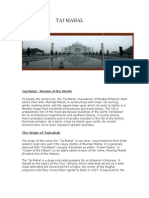0 ratings0% found this document useful (0 votes)
23 viewsYamuna Agra Mughal Emperor Shah Jahan Mumtaz Mahal Mosque Crenellated
Yamuna Agra Mughal Emperor Shah Jahan Mumtaz Mahal Mosque Crenellated
Uploaded by
schauhan12The Taj Mahal in Agra, India was commissioned in 1632 by the Mughal emperor Shah Jahan as a mausoleum for his wife Mumtaz Mahal. It took over 20 years and 20,000 workers to construct the white marble tomb and surrounding formal garden complex. The Taj Mahal is considered one of the finest examples of Mughal architecture and was designated a UNESCO World Heritage Site for being a jewel of Muslim art in India.
Copyright:
© All Rights Reserved
Available Formats
Download as DOCX, PDF, TXT or read online from Scribd
Yamuna Agra Mughal Emperor Shah Jahan Mumtaz Mahal Mosque Crenellated
Yamuna Agra Mughal Emperor Shah Jahan Mumtaz Mahal Mosque Crenellated
Uploaded by
schauhan120 ratings0% found this document useful (0 votes)
23 views1 pageThe Taj Mahal in Agra, India was commissioned in 1632 by the Mughal emperor Shah Jahan as a mausoleum for his wife Mumtaz Mahal. It took over 20 years and 20,000 workers to construct the white marble tomb and surrounding formal garden complex. The Taj Mahal is considered one of the finest examples of Mughal architecture and was designated a UNESCO World Heritage Site for being a jewel of Muslim art in India.
Original Description:
yujm
Original Title
Yamuna
Copyright
© © All Rights Reserved
Available Formats
DOCX, PDF, TXT or read online from Scribd
Share this document
Did you find this document useful?
Is this content inappropriate?
The Taj Mahal in Agra, India was commissioned in 1632 by the Mughal emperor Shah Jahan as a mausoleum for his wife Mumtaz Mahal. It took over 20 years and 20,000 workers to construct the white marble tomb and surrounding formal garden complex. The Taj Mahal is considered one of the finest examples of Mughal architecture and was designated a UNESCO World Heritage Site for being a jewel of Muslim art in India.
Copyright:
© All Rights Reserved
Available Formats
Download as DOCX, PDF, TXT or read online from Scribd
Download as docx, pdf, or txt
0 ratings0% found this document useful (0 votes)
23 views1 pageYamuna Agra Mughal Emperor Shah Jahan Mumtaz Mahal Mosque Crenellated
Yamuna Agra Mughal Emperor Shah Jahan Mumtaz Mahal Mosque Crenellated
Uploaded by
schauhan12The Taj Mahal in Agra, India was commissioned in 1632 by the Mughal emperor Shah Jahan as a mausoleum for his wife Mumtaz Mahal. It took over 20 years and 20,000 workers to construct the white marble tomb and surrounding formal garden complex. The Taj Mahal is considered one of the finest examples of Mughal architecture and was designated a UNESCO World Heritage Site for being a jewel of Muslim art in India.
Copyright:
© All Rights Reserved
Available Formats
Download as DOCX, PDF, TXT or read online from Scribd
Download as docx, pdf, or txt
You are on page 1of 1
Yamuna river in the Indian city of Agra.
It was commissioned in 1632 by the Mughal
emperor, Shah Jahan (reigned from 1628 to 1658), to house the tomb of his favourite
wife, Mumtaz Mahal. The tomb is the centrepiece of a 17-hectare (42-acre)[5] complex, which
includes a mosque and a guest house, and is set in formal gardens bounded on three sides by
a crenellated wall.
Construction of the mausoleum was essentially completed in 1643 but work continued on other
phases of the project for another 10 years. The Taj Mahal complex is believed to have been
completed in its entirety in 1653 at a cost estimated at the time to be around 32 million rupees,
which in 2015 would be approximately 52.8 billion rupees (U.S. $827 million). The construction
project employed some 20,000 artisans under the guidance of a board of architects led by the
court architect to the emperor, Ustad Ahmad Lahauri.
The Taj Mahal was designated as a UNESCO World Heritage Site in 1983 for being "the jewel of
Muslim art in India and one of the universally admired masterpieces of the world's heritage". It is
regarded by many as the best example of Mughal architecture and
You might also like
- Sacred Games (TV Series)Document3 pagesSacred Games (TV Series)schauhan12100% (1)
- YamunaDocument1 pageYamunaschauhan12No ratings yet
- Taj MahalDocument1 pageTaj MahalEr Tushar SainiNo ratings yet
- Taj MahalDocument1 pageTaj MahalYAFETNo ratings yet
- Taj Mahal: Category HistoricDocument1 pageTaj Mahal: Category HistoricAnup MandalNo ratings yet
- Tɑ DƷ MƏ Hɑ L, Tɑ Ʒ-/ Mausoleum Yamuna Agra Mughal Emperor Shah Jahan Tomb Mumtaz Mahal Mosque CrenellatedDocument1 pageTɑ DƷ MƏ Hɑ L, Tɑ Ʒ-/ Mausoleum Yamuna Agra Mughal Emperor Shah Jahan Tomb Mumtaz Mahal Mosque CrenellatedAnamaria-Ileana LăzăroiuNo ratings yet
- T D Ɑ Ʒ MƏ H L/ Ɑ / T / Ɑ Ʒ Persian Mausoleum Yamuna Agra Mughal Emperor Shah Jahan Mumtaz Mahal Mosque CrenellatedDocument1 pageT D Ɑ Ʒ MƏ H L/ Ɑ / T / Ɑ Ʒ Persian Mausoleum Yamuna Agra Mughal Emperor Shah Jahan Mumtaz Mahal Mosque CrenellatedM Su PriyaNo ratings yet
- T D Ɑ Ʒ MƏ H L/ Ɑ / T / Ɑ Ʒ Mausoleum Yamuna Agra Mughal Emperor Shah Jahan Mumtaz Mahal Mosque CrenellatedDocument1 pageT D Ɑ Ʒ MƏ H L/ Ɑ / T / Ɑ Ʒ Mausoleum Yamuna Agra Mughal Emperor Shah Jahan Mumtaz Mahal Mosque CrenellatedAarthi NarayananNo ratings yet
- Tɑ DƷ MƏ Hɑ L/ / Tɑ Ʒ/ Mausoleum Yamuna Agra Mughal Emperor Shah Jahan Mumtaz Mahal Mosque CrenellatedDocument1 pageTɑ DƷ MƏ Hɑ L/ / Tɑ Ʒ/ Mausoleum Yamuna Agra Mughal Emperor Shah Jahan Mumtaz Mahal Mosque Crenellatedremil.kavilNo ratings yet
- T D Ɑ Ʒ MƏ H L/ Ɑ / T / Ɑ Ʒ Mausoleum Yamuna Agra Mughal Emperor Shah Jahan Mumtaz Mahal Mosque CrenellatedDocument1 pageT D Ɑ Ʒ MƏ H L/ Ɑ / T / Ɑ Ʒ Mausoleum Yamuna Agra Mughal Emperor Shah Jahan Mumtaz Mahal Mosque CrenellatedvimalNo ratings yet
- T D Ɑ Ʒ MƏ H L/ Ɑ / T / Ɑ Ʒ Mausoleum Yamuna Agra Mughal Emperor Shah Jahan Mumtaz Mahal Mosque CrenellatedDocument1 pageT D Ɑ Ʒ MƏ H L/ Ɑ / T / Ɑ Ʒ Mausoleum Yamuna Agra Mughal Emperor Shah Jahan Mumtaz Mahal Mosque CrenellatedPhuongNo ratings yet
- Tɑ DƷ MƏ Hɑ L, Tɑ Ʒ-/ Arabic Hindi (Ta DƷ Mɛ Ɦ (Ə) L) Mausoleum Yamuna Agra Mughal Emperor Shah Jahan Tomb Mumtaz Mahal Mosque CrenellatedDocument1 pageTɑ DƷ MƏ Hɑ L, Tɑ Ʒ-/ Arabic Hindi (Ta DƷ Mɛ Ɦ (Ə) L) Mausoleum Yamuna Agra Mughal Emperor Shah Jahan Tomb Mumtaz Mahal Mosque CrenellatedGayani ImbulanaNo ratings yet
- Tɑ DƷ MƏ Hɑ L, Tɑ Ʒ-/ Mausoleum Yamuna Agra Mughal Emperor Shah Jahan Mumtaz Mahal Mosque CrenellatedDocument1 pageTɑ DƷ MƏ Hɑ L, Tɑ Ʒ-/ Mausoleum Yamuna Agra Mughal Emperor Shah Jahan Mumtaz Mahal Mosque CrenellatedTushar SharmaNo ratings yet
- Tɑ DƷ MƏ Hɑ L, Tɑ Ʒ-/ Arabic Hindi (Ta DƷ Mɛ Ɦ (Ə) L) Mausoleum Yamuna Agra Mughal Emperor Shah Jahan Tomb Mumtaz Mahal Mosque CrenellatedDocument1 pageTɑ DƷ MƏ Hɑ L, Tɑ Ʒ-/ Arabic Hindi (Ta DƷ Mɛ Ɦ (Ə) L) Mausoleum Yamuna Agra Mughal Emperor Shah Jahan Tomb Mumtaz Mahal Mosque Crenellatedgeeta rathiNo ratings yet
- Taj MahalDocument1 pageTaj MahalTamaghna DuttaNo ratings yet
- Arfa 2012Document2 pagesArfa 2012AreebaNo ratings yet
- Tɑ DƷ MƏ Hɑ L, Tɑ Ʒ-/ (Ta DƷ Mɛ Ɦ (Ə) L) Mausoleum Yamuna Agra Mughal Emperor Shah Jahan Tomb Mumtaz Mahal Mosque CrenellatedDocument1 pageTɑ DƷ MƏ Hɑ L, Tɑ Ʒ-/ (Ta DƷ Mɛ Ɦ (Ə) L) Mausoleum Yamuna Agra Mughal Emperor Shah Jahan Tomb Mumtaz Mahal Mosque CrenellatedLehanaNo ratings yet
- Taj mahalDocument1 pageTaj mahalkannanmamalasserilNo ratings yet
- Tɑ DƷ MƏ Hɑ L, Tɑ Ʒ-/ Hindi (Ta DƷ Mɛ Ɦ (Ə) L) Mausoleum Yamuna Agra Mughal Emperor Shah Jahan Tomb Mumtaz Mahal Mosque CrenellatedDocument1 pageTɑ DƷ MƏ Hɑ L, Tɑ Ʒ-/ Hindi (Ta DƷ Mɛ Ɦ (Ə) L) Mausoleum Yamuna Agra Mughal Emperor Shah Jahan Tomb Mumtaz Mahal Mosque Crenellatednsivasankar14No ratings yet
- Taj MahalDocument4 pagesTaj MahalVIKKYNo ratings yet
- The Taj MahalDocument1 pageThe Taj Mahalalvinamariya2009No ratings yet
- PML1Document2 pagesPML1jafasoh293No ratings yet
- The Tajmahal: by Zahid Hasan BBA, Royal University of DhakaDocument1 pageThe Tajmahal: by Zahid Hasan BBA, Royal University of DhakaZahid HasanNo ratings yet
- Rupees U.S. $ Ustad Ahmad Lahauri Unesco World Heritage Site Mughal Architecture New7Wonders of The WorldDocument1 pageRupees U.S. $ Ustad Ahmad Lahauri Unesco World Heritage Site Mughal Architecture New7Wonders of The WorldshivaniNo ratings yet
- Taj Mahal Was Chosen For Its Beautiful ArchitectureDocument2 pagesTaj Mahal Was Chosen For Its Beautiful ArchitectureSolo En NorcoreaNo ratings yet
- Taj MahalDocument3 pagesTaj MahalvihaanvrsNo ratings yet
- taj mahal (3)Document2 pagestaj mahal (3)Arjun KrNo ratings yet
- Taj Mahal - WikipediaDocument10 pagesTaj Mahal - WikipediaPritimasuman DasNo ratings yet
- The 7 Wonders of The Modern WorldDocument2 pagesThe 7 Wonders of The Modern WorldMaria Angelica Moreno O.No ratings yet
- Taj MahalDocument2 pagesTaj MahalALISSON GEOVANNA LEMA CHAVEZNo ratings yet
- Mughal Monuments: Humayun's Tomb (Maqbara e Humayun) Is The Tomb of The Mughal Emperor Humayun in Delhi, India. TheDocument2 pagesMughal Monuments: Humayun's Tomb (Maqbara e Humayun) Is The Tomb of The Mughal Emperor Humayun in Delhi, India. Thehodibaaba1No ratings yet
- ICT MICRO PDocument3 pagesICT MICRO PNarendra KambleNo ratings yet
- Taj Mahal - WikipediaDocument30 pagesTaj Mahal - Wikipediameenakshikumawat601No ratings yet
- Discribsing Places of Taj MahalDocument9 pagesDiscribsing Places of Taj MahalFarenndra AdhiNo ratings yet
- Taj MahalDocument5 pagesTaj MahalvishavjeetsinghmodgilNo ratings yet
- Taj MahalDocument2 pagesTaj MahalRaechelle Jhay ZafraNo ratings yet
- Taj Mahal WoiDocument2 pagesTaj Mahal WoiKhairul AmirulNo ratings yet
- Taj Mahal - Symbol of LoveDocument7 pagesTaj Mahal - Symbol of LoveArun K GuptaNo ratings yet
- Project Management-Taj MahalDocument20 pagesProject Management-Taj MahalAbdul Ghani67% (3)
- Indian ArchiDocument13 pagesIndian Archiarisjfelina033No ratings yet
- PML3Document2 pagesPML3jafasoh293No ratings yet
- Taj Mahal: Origin and InspirationDocument2 pagesTaj Mahal: Origin and InspirationVipin KumarNo ratings yet
- Taj MahalDocument1 pageTaj MahalAnnabethNo ratings yet
- History of Taj MahalDocument5 pagesHistory of Taj MahalManthira ChimizhNo ratings yet
- Taj MahalDocument3 pagesTaj Mahaltravel_memoriesNo ratings yet
- Taj Mahal - Wonder of The WorldDocument4 pagesTaj Mahal - Wonder of The WorldRizwan ChouhanNo ratings yet
- Taj MahalDocument16 pagesTaj Mahalgirish_gupta509575No ratings yet
- Assignment: The Taj MahalDocument4 pagesAssignment: The Taj MahalYuki ShizukuNo ratings yet
- Proyecto Taj MahalDocument2 pagesProyecto Taj Mahaldannacr108No ratings yet
- UNESCO World Heritage Site of Agra - Taj MahalDocument2 pagesUNESCO World Heritage Site of Agra - Taj MahalAgra Taj Mahal ToursNo ratings yet
- Seven Wonders of WorldDocument1 pageSeven Wonders of WorldTutor Seri KembanganNo ratings yet
- Document 22Document4 pagesDocument 22Dillion BradleyNo ratings yet
- The EmperorDocument4 pagesThe EmperorRicha MishraNo ratings yet
- Taj Mahal - Net SearchDocument4 pagesTaj Mahal - Net SearchjitenderaNo ratings yet
- Study On The Architecture of Taj Mahal: Narjes Falakian, Ali FalakianDocument7 pagesStudy On The Architecture of Taj Mahal: Narjes Falakian, Ali Falakianjanhavi28No ratings yet
- Taj_MahalDocument1 pageTaj_Mahalkikilily247No ratings yet
- Taj MehalDocument3 pagesTaj MehalDanish DanishNo ratings yet
- Taj MahalDocument9 pagesTaj Mahalsnigdhabanerjee1985No ratings yet
- Taj MahalDocument2 pagesTaj MahalJyotiraditya Kumar JhaNo ratings yet
- General Studies Project: Taj Mahal: The True StoryDocument21 pagesGeneral Studies Project: Taj Mahal: The True StoryAyaan PunjabiNo ratings yet
- Golaknath CaseDocument2 pagesGolaknath Caseschauhan12No ratings yet
- State of Uttar Pradesh v. Raj Narain: See AlsoDocument2 pagesState of Uttar Pradesh v. Raj Narain: See Alsoschauhan12No ratings yet
- Abu'l-Fath Jalal-Ud-Din Muhammad AkbarDocument1 pageAbu'l-Fath Jalal-Ud-Din Muhammad Akbarschauhan12No ratings yet
- Sacred GamesDocument4 pagesSacred Gamesschauhan120% (1)
- World War OneDocument7 pagesWorld War Oneschauhan120% (1)
- Dynamic Load Test: Motion or Acceleration TransducerDocument2 pagesDynamic Load Test: Motion or Acceleration Transducerschauhan12No ratings yet
- World War OneDocument8 pagesWorld War Oneschauhan12No ratings yet
- Sun LawnDocument1 pageSun Lawnschauhan12No ratings yet
- "World War One", "Great War", and "WW1" Redirect Here. For Other Uses, See,, andDocument5 pages"World War One", "Great War", and "WW1" Redirect Here. For Other Uses, See,, andschauhan12No ratings yet
- Arms Race: SMS RheinlandDocument5 pagesArms Race: SMS Rheinlandschauhan12No ratings yet
- LawnDocument1 pageLawnschauhan12No ratings yet
- Lan/llan/laun: Lawn Is An Area of Soil-Covered Land Planted WithDocument1 pageLan/llan/laun: Lawn Is An Area of Soil-Covered Land Planted Withschauhan12No ratings yet
- LawnDocument1 pageLawnschauhan12No ratings yet
- LawnDocument1 pageLawnschauhan12No ratings yet
- Lawn Is An Area of Soil-Covered Land Planted With: Lan/llan/launDocument1 pageLawn Is An Area of Soil-Covered Land Planted With: Lan/llan/launschauhan12No ratings yet
- Lawn Is An Area of Soil-Covered Land Planted With: Lan/llan/launDocument1 pageLawn Is An Area of Soil-Covered Land Planted With: Lan/llan/launschauhan12No ratings yet
- Lan/llan/laun: Lawn Is An Area of Soil-Covered Land Planted WithDocument1 pageLan/llan/laun: Lawn Is An Area of Soil-Covered Land Planted Withschauhan12No ratings yet
- Lan/llan/laun: Lawn Is An Area of Soil-Covered Land Planted WithDocument1 pageLan/llan/laun: Lawn Is An Area of Soil-Covered Land Planted Withschauhan12No ratings yet
- Lan/llan/laun: Lawn Is An Area of Soil-Covered Land Planted WithDocument1 pageLan/llan/laun: Lawn Is An Area of Soil-Covered Land Planted Withschauhan12No ratings yet
- Lan/llan/laun: Lawn Is An Area of Soil-Covered Land Planted WithDocument1 pageLan/llan/laun: Lawn Is An Area of Soil-Covered Land Planted Withschauhan12No ratings yet
- Lawn Is An Area of Soil-Covered Land Planted With: Lan/llan/launDocument1 pageLawn Is An Area of Soil-Covered Land Planted With: Lan/llan/launschauhan12No ratings yet
- Grasses Clover Lawnmower Weed Pest Control: Lawn Is An Area of Soil-Covered Land Planted WithDocument1 pageGrasses Clover Lawnmower Weed Pest Control: Lawn Is An Area of Soil-Covered Land Planted Withschauhan12No ratings yet
- History: EtymologyDocument9 pagesHistory: Etymologyschauhan12No ratings yet



















































































